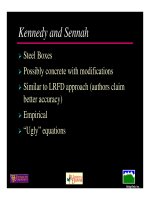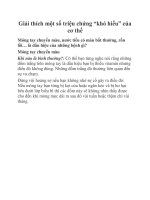Giải thích hệ số PBN - Kennedy and Sennah
Bạn đang xem bản rút gọn của tài liệu. Xem và tải ngay bản đầy đủ của tài liệu tại đây (591.98 KB, 26 trang )
BridgeTech, Inc.
Kennedy and Sennah
Steel Boxes
Possibly concrete with modifications
Similar to LRFD approach (authors claim
better accuracy)
Empirical
“Ugly” equations
BridgeTech, Inc.
European Practice
BridgeTech, Inc.
Examples
AASHTO LRFD
Henry (old method)
CSA
Sanders and Elleby
BridgeTech, Inc.
Summary
Moment Shear Moment Shear Moment Shear Moment Shear
AASHTO LRFD 0.694 0.955 0.840 0.840 0.732 0.884 0.733 0.733
Canadian Bridge Design Code 0.895 0.895 1.034 1.034 0.783 0.783 0.930 0.930
Sanders and Elleby 0.710 0.710 0.710 0.710 0.946 0.946 0.946 0.946
Equal Distribution Factor Method 0.774 0.774 0.774 0.774 0.655 0.655 0.655 0.655
Interior Exterior
PCI Example 4
Interior Exterior
Method
AISI Example 2
BridgeTech, Inc.
Task 2 – Range of structural forms, materials
and range of application
Range of application
There is no reason at this point to limit range of
application (we can include range outside of
conventional practice and geometries)
“All” parameters will be included in the
database
A large amount of data is available from
several sources (see Task 6 tables)
Additional data can be added
BridgeTech, Inc.
Task 3 -- Analytical method
Mathematical model
Equilibrium,
compatibility, and
constitutive
relationships
Beam theory
Kirchhoff plate theory
Results in governing
ODE or PDF
4
4
p x
d w
dx EI x
4
,p x y
w
D
BridgeTech, Inc.
Task 3 -- Analytical method
Numerical methods
Finite difference
Finite element method (plate or shell elements)
Grillage
Finite Strip Method
Harmonic analysis (Sanders and Elleby)
BridgeTech, Inc.
Theorem Requirements
Calculated internal actions and applied
forces are in equilibrium
Materials and section/member behavior
must be ductile
Independent of the
modeling assumptions!
No instability or fracture
BridgeTech, Inc.
The lower bound theorem is
one of the most important
theorems/concepts in
structural engineering.
BridgeTech, Inc.
The lower bound theorem is
one of the most important
theorems/concepts in
structural engineering.
Offers wonderful assurance as the models
are often simple approximations to the
real world.









